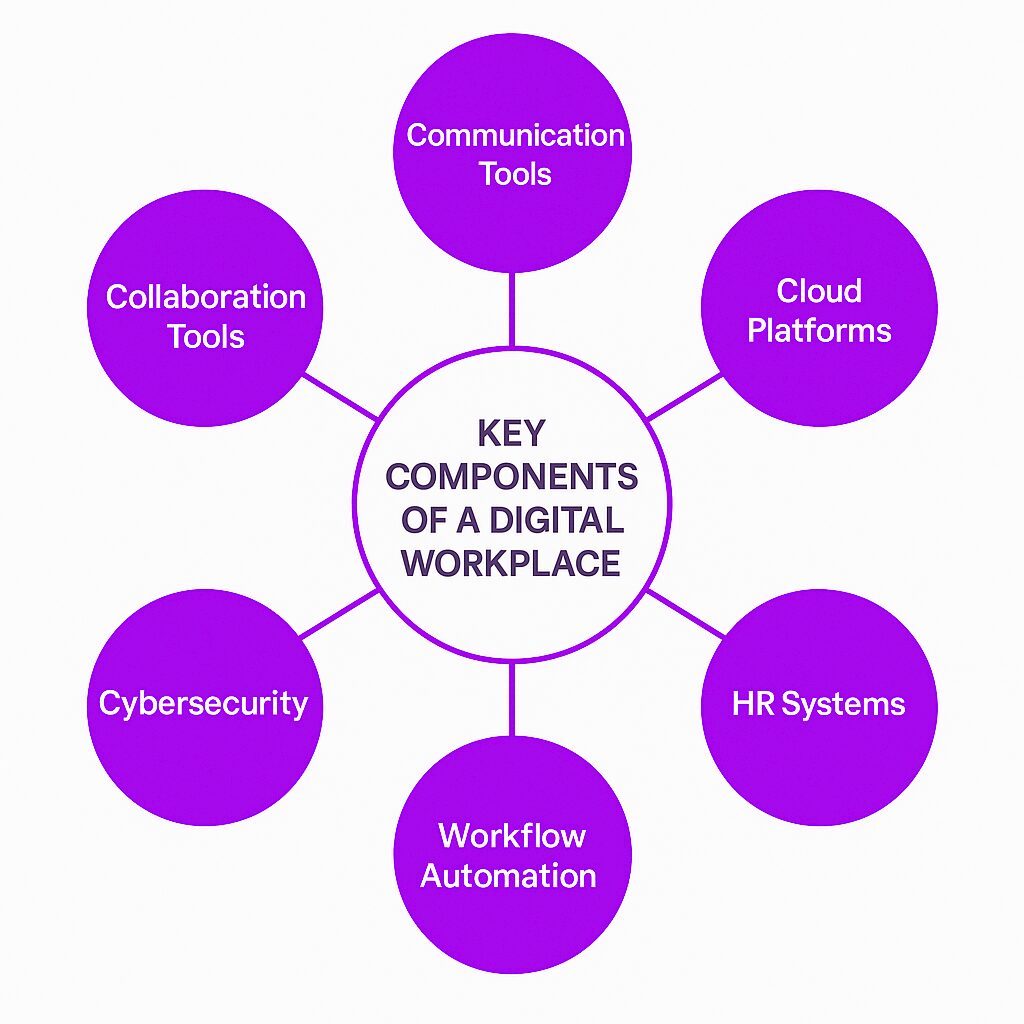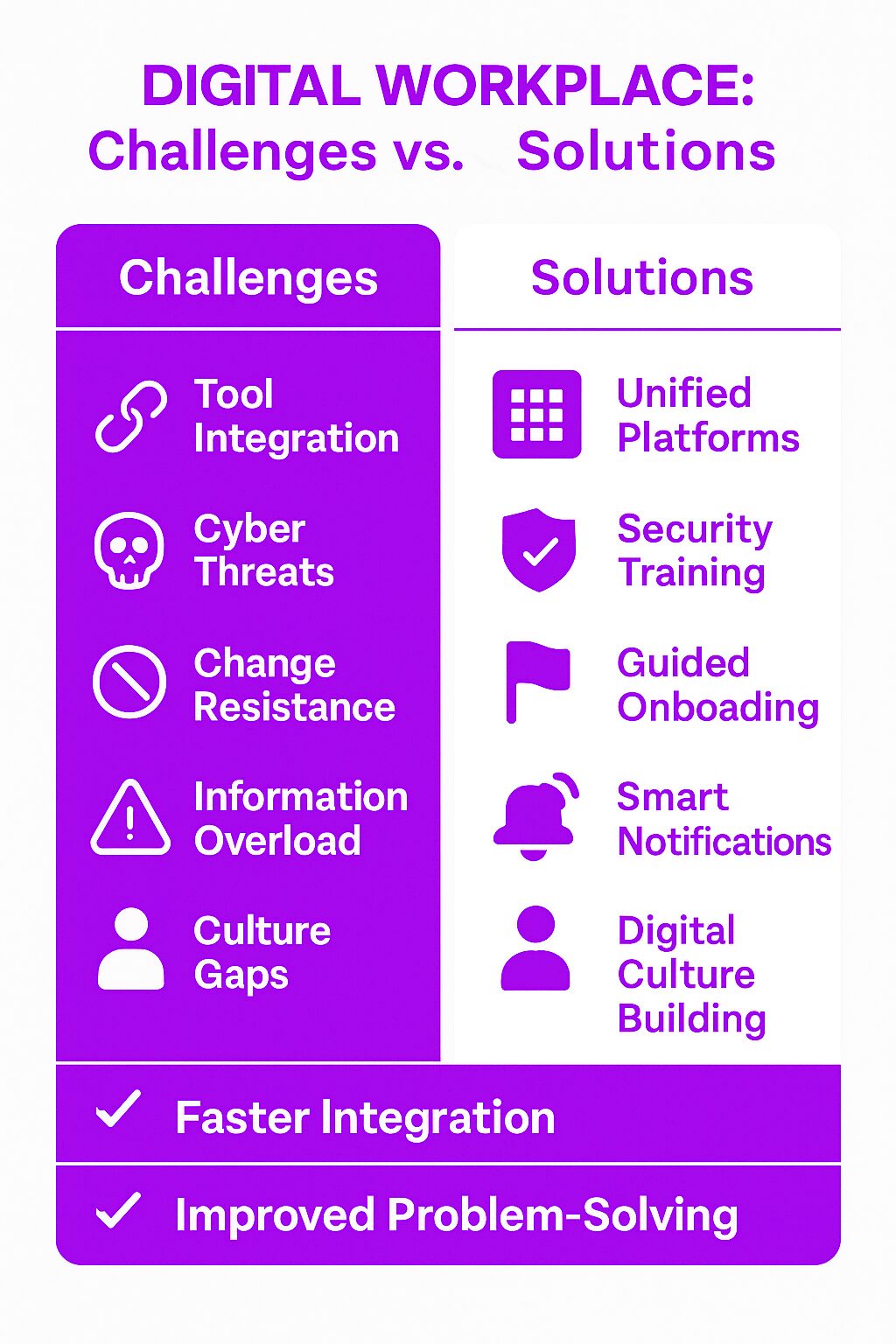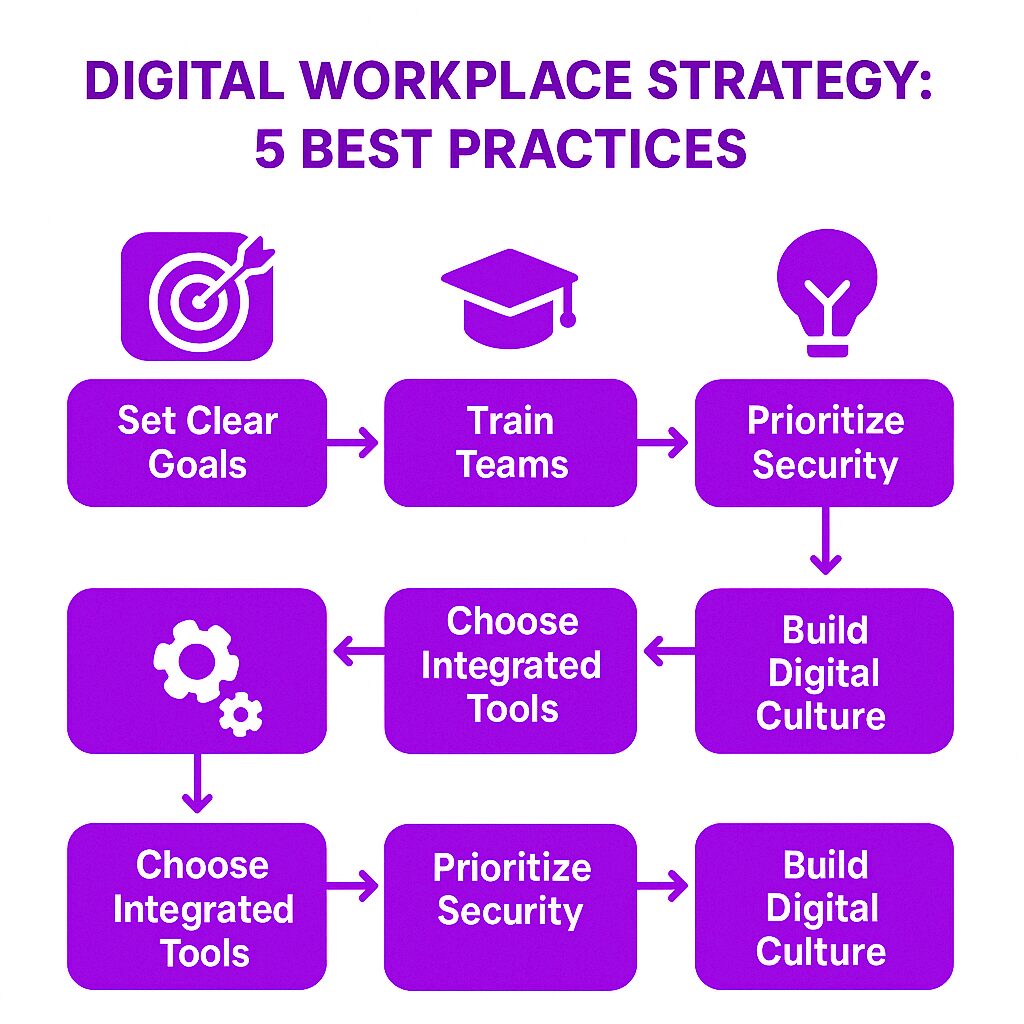What Is a Digital Workplace?
A digital workplace is a virtual environment that integrates digital tools, communication platforms, and cloud-based solutions to enhance collaboration, productivity, and efficiency. Unlike traditional offices bound by physical locations, a digital workplace enables employees to work from anywhere, access information seamlessly, and interact with colleagues in real time.
The shift to digital workplaces is driven by technological advancements, evolving workforce expectations, and the need for businesses to stay agile in an increasingly digital world. Companies that successfully implement a digital workplace create a more connected, productive, and flexible work environment that supports both in-office and remote teams. Essential digital workplace components include communication tools, technology stack, and work culture, each playing a crucial role in facilitating collaboration and enhancing overall workplace efficiency.
How a Digital Workplace Functions
A digital workplace operates as an ecosystem of integrated tools that enhance organizational efficiency by merging technology with business processes. It includes:
-
Communication Tools – Instant messaging, video conferencing, and collaboration apps.
-
Project Management Software – Platforms that enable task tracking, resource allocation, and team coordination.
-
Cloud-Based File Storage – Secure, accessible storage for documents and shared workspaces.
-
HR and Employee Experience Platforms – Digital tools that streamline onboarding, performance tracking, and benefits management.
-
Automation and AI Integration – Intelligent workflows that reduce manual tasks and improve efficiency.
-
Cybersecurity Measures – Identity authentication, data encryption, and endpoint security to protect sensitive information.
Key Components of a Digital Workplace
1. Communication and Collaboration Tools
Effective communication is the foundation of a digital workplace. Teams rely on digital tools to share updates, discuss projects, and collaborate in real time. Common platforms include:
-
Messaging Apps – Slack, Microsoft Teams, Google Chat
-
Video Conferencing – Zoom, Webex, Google Meet
-
Virtual Whiteboards – Miro, MURAL, Microsoft Whiteboard
However, digital workplace challenges such as organizational silos and complicated collaboration can be mitigated by using effective communication tools that promote alignment and agile operational practices.
2. Cloud-Based Work Environments
Cloud computing enables employees to access files, applications, and work systems from any device, reducing the dependency on physical infrastructure. Popular cloud solutions include:
-
Google Workspace (Docs, Sheets, Drive)
-
Microsoft 365 (Word, Excel, OneDrive)
-
Dropbox, Box, and AWS Cloud Storage
3. Employee Experience and HR Platforms
A digital workplace enhances employee engagement by simplifying HR processes, benefits management, and career development. Leading platforms include:
-
Workday (HR and finance management)
-
BambooHR (Human resource software)
-
SAP SuccessFactors (Talent management)
4. Task and Workflow Automation
Automating repetitive tasks with digital workplace tools improves efficiency, facilitates efficient workflows, and fosters collaboration. Workflow automation tools include:
-
Zapier (Connecting different apps)
-
Microsoft Power Automate (Automating business workflows)
-
Monday.com (Task automation and project tracking)
5. Cybersecurity Infrastructure
A secure digital workplace is critical to enhance data protection and prevent cyber threats. Key security measures include:
-
Multi-Factor Authentication (MFA)
-
End-to-end encryption
-
Role-based access control (RBAC)
Purpose and Importance of a Digital Workplace
1. Enhancing Employee Productivity
Digital workplaces eliminate redundant processes and automate workflows, enabling employees to focus on meaningful tasks.
Integrating a digital workplace solution can further enhance employee engagement and training by bridging the gap between employees and technology, thus promoting effective collaboration in a modern workplace.
2. Facilitating Remote and Hybrid Work
With cloud-based access and digital collaboration tools, employees can work from anywhere without disruption. A digital work environment demands effective systems for tracking projects and improving work-life balance.
3. Improving Business Agility
A digital-first environment enables companies to respond quickly to market shifts, industry changes, and technological advancements.
4. Enhancing Employee Engagement
By providing seamless access to resources, self-service HR portals, and intuitive collaboration tools, companies create a more engaged workforce.
5. Ensuring Business Continuity
Digital workplaces minimize downtime by enabling operations to continue seamlessly during disruptions, such as natural disasters or global crises.
Benefits of a Digital Workplace
1. Increased Flexibility
Employees can work from home, in the office, or on the go without losing access to essential tools and information. Flexible work schedules and the ability to work remotely contribute to enhanced work-life balance and employee satisfaction, ultimately resulting in a happier workforce.
2. Improved Collaboration
Teams can connect in real time, eliminating communication silos and streamlining decision-making.
3. Higher Employee Satisfaction
A well-structured digital workplace reduces frustrations associated with outdated tools and inefficient processes.
4. Cost Savings
By reducing reliance on physical office spaces, businesses save on overhead costs such as rent, utilities, and office supplies.
5. Better Decision-Making
Data-driven insights from digital tools help leadership make informed decisions faster and more accurately.
Challenges of a Digital Workplace
1. Integration Issues
Ensuring that various tools and platforms work seamlessly together can be complex and require ongoing IT support.
2. Security Risks
The increased reliance on digital tools exposes businesses to cybersecurity threats. Strong security policies and employee training are essential. Employee data breaches worldwide, alongside continuous phishing scams, represent major challenges in cyber and information security for digital workplaces, emphasizing the need for effective security awareness programs.
3. Employee Resistance to Change
Some employees may struggle to adapt to new digital tools, necessitating comprehensive training programs.
4. Information Overload
Too many digital tools and constant notifications can overwhelm employees, leading to decreased productivity.
5. Maintaining Company Culture
With remote teams and digital-first interactions, businesses must find ways to foster a strong, connected workplace culture.
Digital Workplace Strategy
A digital workplace strategy is a comprehensive plan that outlines how an organization will leverage technology to create a seamless and productive work environment. This strategy is crucial for aligning business goals with technology solutions, ultimately enhancing the digital employee experience, improving collaboration, and increasing productivity.
Best Practices for Implementing a Digital Workplace Strategy
1. Define Clear Goals
Organizations should align digital workplace initiatives with business objectives, ensuring technology investments drive meaningful outcomes.
2. Provide Comprehensive Training
Educating employees on how to effectively use digital tools ensures a smooth transition and maximizes adoption rates.
3. Invest in Integrated Solutions
Choosing tools that seamlessly connect reduces friction and prevents workflow bottlenecks.
4. Prioritize Cybersecurity
Implementing strong access controls, conducting regular security audits, and training employees on cybersecurity best practices help protect digital workplaces.
5. Foster a Digital-First Culture
Encouraging innovation, adaptability, and collaboration ensures employees fully embrace the digital workplace.
Measuring the Success of a Digital Workplace
Measuring the success of a digital workplace is crucial to understanding its impact on employee experience, productivity, and business outcomes. Key performance indicators (KPIs) provide valuable insights into the effectiveness of a digital workplace strategy, enabling organizations to make data-driven decisions.
Real-World Examples of Digital Workplaces
1. Google’s Digital Workplace
Google’s cloud-based infrastructure enables seamless remote work, real-time collaboration, and data-driven decision-making.
2. Microsoft’s Hybrid Work Model
Microsoft leverages Microsoft 365 and Teams to support hybrid work environments, ensuring employees stay connected regardless of location.
3. Amazon’s AI-Driven Operations
Amazon uses AI-powered logistics, cloud computing, and virtual collaboration tools to optimize efficiency and customer service.
4. Healthcare Digital Transformation
Hospitals and clinics adopt telemedicine platforms, electronic health records (EHRs), and AI-driven diagnostics to enhance patient care. Digital workplaces enable businesses to optimize resources and enhance operational efficiency, facilitating adaptability during crises and enabling agility in response to market changes.
Future of Digital Workplaces
The digital workplace will continue evolving with AI-driven automation, virtual reality (VR) for immersive collaboration, and blockchain for secure transactions. Companies that invest in digital transformation will gain a competitive edge, improving efficiency, employee experience, and long-term success.
As businesses adopt a digital-first approach, the workplace will become more agile, adaptive, and responsive to the needs of an increasingly remote and tech-savvy workforce. This shift reduces the reliance on physical office space, reflecting a move from traditional office settings to more flexible and digital-centric work environments.







